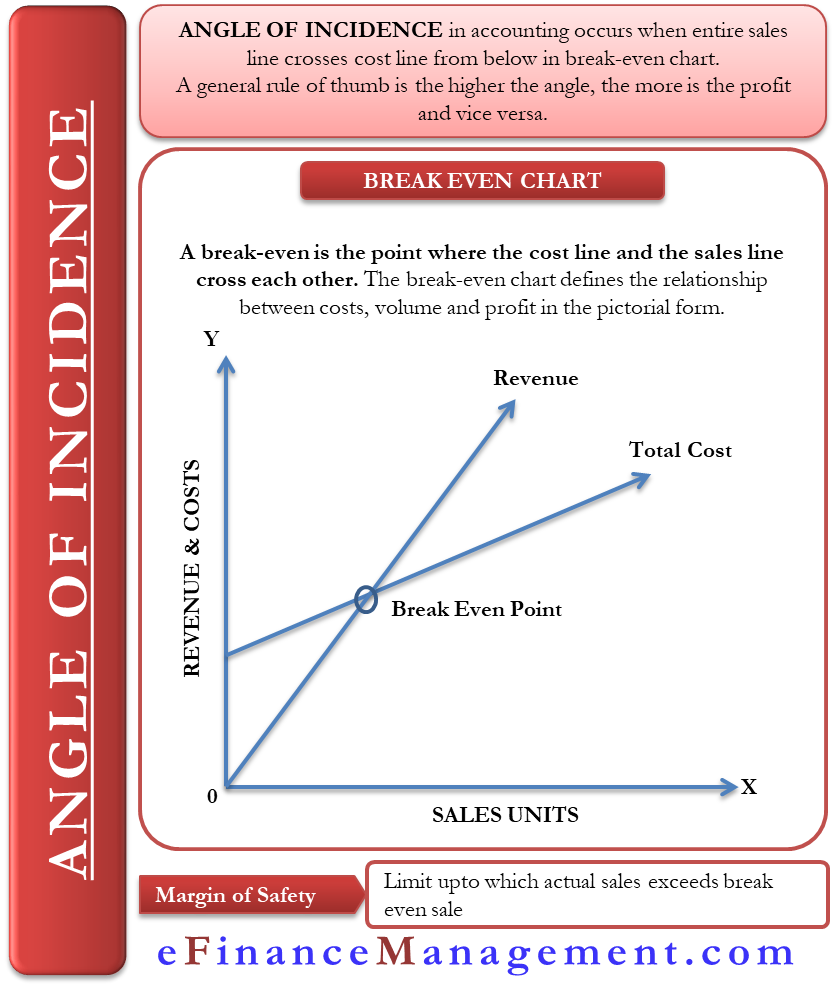The Angle of Incidence in accounting occurs when the entire sales line crosses the cost line from below in the break-even chart. Or, it is an angle that gets created due to the sale and cost line. Usually, this angle starts forming at the break-even point, indicating how efficiently the company is making a profit. Further, the angle suggests that the rate at which the company is making profits.
A general rule of thumb is the higher the angle, the more the profit and vice versa. A large angle of incidence means the company is making profits at a higher rate. Similarly, a small angle suggests the profit is being earned at a lower rate.
Additionally, it gives one more significant information. If the angle of incidence is small, it means the company is incurring more variable costs. Thus, for a business, a desirable situation is a large angle of incidence with a high margin of safety. It could further indicate that the business might have a monopoly status in its industry.
Break-Even Chart
Since Angle of Incidence is on the break-even chart, it becomes important to understand the concept. Break-even is the point where the cost line and the sales line cross each other. Businesses make use of break-even techniques to ensure sound profit planning. The break-even chart depicts the break-even point graphically. The break-even chart defines the relationship between costs, volume, and profit in the pictorial form.
Now, let’s see how to construct a break-even chart;
- First, you need to plot sales on the horizontal axis. You can also plot production in units on the same axis.
- On the vertical axis, you will have to plot costs and revenue.
- After that, you need to plot a fixed cost line running parallel on the horizontal axis.
- The variable cost line should originate from the point on the vertical axis.
- Lastly, draw the sales line, which should start from the zero point. It should finish at the point of the maximum scale.
As said above, the angle of incidence is the one that gets created due to the total sale and total cost line. The angle originates from the BEP (break-even point). It represents the whole area between the two lines. The larger the area, the bigger the profit that a company is making, and the more cushion the company has in times of distress.

Angle of Incidence, Break-Even and Margin of Safety – Relation
Before understanding the relationship between the three, it is important to understand what the Margin of Safety is. It is basically the limit to which the actual or estimated sales exceed the break-even sales. You get a margin of safety ratio after subtracting the actual sales from the break-even sales and dividing the result by actual sales.
In simpler terms, the margin of safety measures the business risk. A company with a higher margin of safety is more likely to sustain the volatile conditions and maintain its sales. However, if the sales drop more than the margin of safety, it would result in a net loss for the period.
If the break-even sales are low and the angle of incidence is large, it reflects that the business is stable. This would also mean that the margin of safety would be high. If the break-even sales are slightly lower with a moderate angle of incidence, we can consider the business to be stable. However, the company is not making as much profit as in the first case. A third situation is where the break-even sales are higher, the angle of incidence would be narrow, and the margin of safety sales would be low as well.
Also Read: Break Even Point
Final Words
From the above information, it is clear that the angle of incidence is related to the break-even point. Thus, one should study it along with the break-even point; otherwise, it won’t give any meaningful information.

